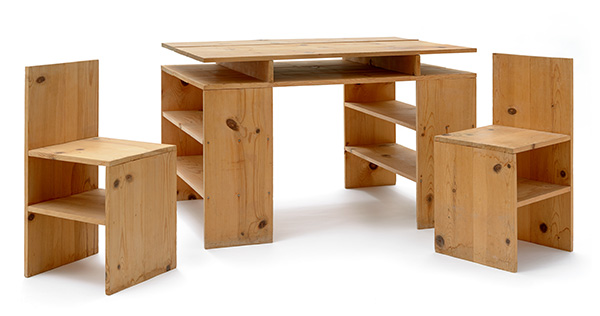Press Release - Huntington and LACMA Jointly Acquire Two Donald Judd Prototype Chairs
Posted on Mon., Feb. 13, 2017

Chairs join a prototype desk already in LACMA’s collection to complete what will be a jointly owned suite

Donald Judd, Prototype Desk and Chairs, 1978-1980. Donald Judd Furniture © 2017 Judd Foundation / Artists Rights Society (ARS), New York.
SAN MARINO AND LOS ANGELES, Calif.— The Huntington Library, Art Collections, and Botanical Gardens and the Los Angeles County Museum of Art (LACMA) announced today their joint acquisition of two prototype chairs (1979–80) made by American artist Donald Judd (1928–1994). The chairs will join a Judd prototype desk (1978) that LACMA acquired in 2011, thus uniting a suite that will be co-owned by the two institutions. The group will go on view at The Huntington in 2018.
"We're delighted to join forces with LACMA in bringing these seminal works to the public," said Kevin Salatino, Hannah and Russel Kully Director of the Art Collections at The Huntington. "We already co-own an icon of modern design with LACMA—Arthur Mackmurdo's Century Guild Dining Chair of 1883—and now will share these more recent masterworks of modernism. Along with The Huntington's important holdings of furniture by Frank Lloyd Wright, Greene & Greene, and Charles Rohlfs, the Judd suite extends a continuum of progressive design and theory, while at the same time eliding the categories of furniture and sculpture. I thank Michael Govan for his proposal to share this important acquisition with The Huntington, and Kelvin Davis, who is a Trustee of LACMA and sits on the Board of Overseers of The Huntington, for his generosity in supporting both the 2011 and 2016 acquisitions."
Though widely recognized for his sculpture, Judd’s furniture—reductive, free of extraneous detail, and informed by influences ranging from the Shakers to De Stijl designer Gerritt Rietveld—is less well known. The newly acquired chairs were built as part of his adaptive reuse of historic buildings in Marfa, Texas, where he converted largely abandoned buildings into living spaces, studios, and museum galleries.
Unable to find furniture locally that suited his architecture, he decided to make his own out of pine, including the newly acquired chairs and desk, which were later put into commercial production in a variety of fine woods. Their design relates to the formal logic of Judd’s famous box sculptures, set at perpendicular angles to create the elements of back, seat, and legs.
“As one of the most important American artists of the 20th century, Judd plays a crucial part in the dialogue between art and design in LACMA’s collection,” said Michael Govan, LACMA CEO and Wallis Annenberg Director, who participated in a public talk with Donald Judd’s son Flavin Judd at LACMA today that touched on the acquisition. “Furniture in LACMA’s collection is often not just about formal design, but about ideas—the global aesthetic philosophies of the Arts and Crafts Movement to the revolution in thinking about domestic living embedded in the furniture of R.M. Schindler. The Judd desk and chairs are a landmark addition to that. It is a coup for Los Angeles and all the more relevant to be shared with The Huntington’s exceptional American collections. Originally designed for his children, the desk and chairs represent the very beginnings of Judd’s thinking about furniture as well as about how he could make his young children feel comfortable in his unusual home in a small West Texas desert town.”
At The Huntington, the history of modern furniture and decorative art has been a collecting interest for some time. In the Huntington Art Gallery, the British Design Reform movement is represented by several examples, including a ladder-back chair by Charles Rennie Mackintosh (1903). The American art galleries display such pieces as Samuel Gragg’s early modernist ‘Elastic’ side chair (1810), Frank Furness’s monumental chair from the 1870s, Charles Rohlf’s design-forward rocking chair (ca. 1899), Frank Lloyd Wright’s Husser House dining table and chairs (1899), and a dramatically designed gallery highlighting the work of Arts & Crafts masters Charles and Henry Greene.
While the Decorative Arts and Design department’s holdings at LACMA range from medieval to the present, the modern and contemporary collections are a particular strength. In addition to having one of the country’s most comprehensive collections of furnishings from the turn-of-the-century Arts and Crafts movement, the LACMA collection also includes masterworks from most European countries throughout the 20th century as well as Mexico and Japan, with objects that speak to the many international communities of Los Angeles.
# # #
Contacts
Thea M. Page, 626-405-2260, tpage@huntington.org
Miranda Carroll, 323-857-6522, mcarroll@lacma.org
About LACMA
Since its inception in 1965, the Los Angeles County Museum of Art (LACMA) has been devoted to collecting works of art that span both history and geography, in addition to representing Los Angeles's uniquely diverse population. Today LACMA is the largest art museum in the western United States, with a collection that includes over 130,000 objects dating from antiquity to the present, encompassing the geographic world and nearly the entire history of art. Among the museum’s strengths are its holdings of Asian art; Latin American art, ranging from masterpieces from the Ancient Americas to works by leading modern and contemporary artists; and Islamic art, of which LACMA hosts one of the most significant collections in the world. A museum of international stature as well as a vital part of Southern California, LACMA shares its vast collections through exhibitions, public programs, and research facilities that attract over one million visitors annually, in addition to serving millions through digital initiatives such as online collections, scholarly catalogues, and interactive engagement. LACMA is located in Hancock Park, 30 acres situated at the center of Los Angeles, which also contains the La Brea Tar Pits and Museum and the forthcoming Academy Museum of Motion Pictures. Situated halfway between the ocean and downtown, LACMA is at the heart of Los Angeles.
Location and Contact: 5905 Wilshire Boulevard (at Fairfax Avenue), Los Angeles, CA, 90036. Phone: 323-857-6000. lacma.org